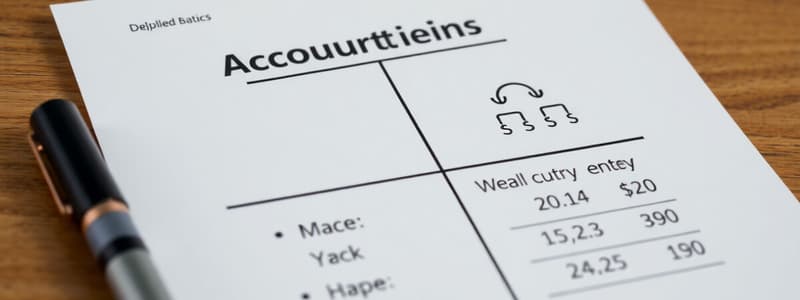Podcast
Questions and Answers
What are the records that summarize all financial transactions over a period for an entity called?
What are the records that summarize all financial transactions over a period for an entity called?
- Ledgers
- Statements
- Reports
- Accounts (correct)
Which of the following is NOT a type of account?
Which of the following is NOT a type of account?
- Personal Accounts
- Nominal Accounts
- Real Accounts
- Temporary Accounts (correct)
In the accounting equation, what do assets equal?
In the accounting equation, what do assets equal?
- Equity - Liabilities
- Expenses + Equity
- Liabilities + Revenues
- Liabilities + Equity (correct)
What do debits increase according to the double-entry system?
What do debits increase according to the double-entry system?
Which financial statement provides a snapshot of assets, liabilities, and equity at a certain point in time?
Which financial statement provides a snapshot of assets, liabilities, and equity at a certain point in time?
What does the accrual principle in accounting require?
What does the accrual principle in accounting require?
Which principle assumes that a business will continue to operate indefinitely?
Which principle assumes that a business will continue to operate indefinitely?
What is the purpose of a journal in accounting?
What is the purpose of a journal in accounting?
What do Generally Accepted Accounting Principles (GAAP) guide?
What do Generally Accepted Accounting Principles (GAAP) guide?
Which of the following is a tool commonly used for budget tracking and financial analysis?
Which of the following is a tool commonly used for budget tracking and financial analysis?
Flashcards are hidden until you start studying
Study Notes
Fundamentals of Accounts
Basic Concepts
- Definition: Accounts are records that summarize all financial transactions over a period for an entity.
- Types of Accounts:
- Real Accounts: Assets and liabilities, e.g., cash, land.
- Personal Accounts: Individuals or organizations, e.g., accounts receivable.
- Nominal Accounts: Expenses and income, e.g., rent, sales.
Accounting Equation
- Equation: Assets = Liabilities + Equity
- Assets: Resources owned by the entity.
- Liabilities: Obligations owed to outsiders.
- Equity: Owner's interest in the assets.
Double-Entry System
- Each transaction affects at least two accounts.
- Consists of debits and credits:
- Debit: Increases in assets or expenses; decreases in liabilities or equity.
- Credit: Increases in liabilities or equity; decreases in assets or expenses.
Financial Statements
- Balance Sheet: Snapshot of assets, liabilities, and equity at a point in time.
- Income Statement: Summary of revenues and expenses over a period, showing net profit or loss.
- Cash Flow Statement: Shows cash inflows and outflows from operating, investing, and financing activities.
Key Principles
- Accrual Principle: Revenues and expenses recorded when earned or incurred, regardless of cash movement.
- Consistency Principle: Use of the same accounting methods over time for comparability.
- Going Concern: Assumption that the entity will continue to operate indefinitely.
Key Terms
- Journal: The book of original entry where transactions are recorded chronologically.
- Ledger: Compilation of accounts where individual transactions are posted.
- Trial Balance: A summary list of all accounts with balances, used to verify that debits equal credits.
Important Concepts
- GAAP: Generally Accepted Accounting Principles guide accounting standards and practices.
- Reconciliation: The process of ensuring two sets of records (usually the balances of two accounts) are in agreement.
Tools and Technologies
- Accounting Software: Programs like QuickBooks or Xero assist in maintaining accounts effectively.
- Spreadsheets: Often utilized for budget tracking and financial analysis.
Conclusion
Understanding the fundamentals of accounts is essential for accurate financial reporting, compliance, and making informed business decisions.
Fundamentals of Accounts
- Definition: Accounts are records that summarize all financial transactions over a period for an entity.
- Types of Accounts:
- Real Accounts: Assets and liabilities, e.g., cash, land.
- Personal Accounts: Individuals or organizations, e.g., accounts receivable.
- Nominal Accounts: Expenses and income, e.g., rent, sales.
Accounting Equation
- Equation: Assets = Liabilities + Equity
- Assets: Resources owned by the entity.
- Liabilities: Obligations owed to outsiders.
- Equity: Owner's interest in the assets.
Double-Entry System
- Each transaction affects at least two accounts.
- It consists of debits and credits:
- Debit: Increases in assets or expenses; decreases in liabilities or equity.
- Credit: Increases in liabilities or equity; decreases in assets or expenses.
Financial Statements
- Balance Sheet: Snapshot of assets, liabilities, and equity at a point in time.
- Income Statement: Summary of revenues and expenses over a period, showing net profit or loss.
- Cash Flow Statement: Shows cash inflows and outflows from operating, investing, and financing activities.
Key Principles
- Accrual Principle: Revenues and expenses are recorded when earned or incurred, regardless of cash movement.
- Consistency Principle: Use of the same accounting methods over time for comparability.
- Going Concern: Assumption that the entity will continue to operate indefinitely.
Key Terms
- Journal: The book of original entry where transactions are recorded chronologically.
- Ledger: Compilation of accounts where individual transactions are posted.
- Trial Balance: A summary list of all accounts with balances, used to verify that debits equal credits.
Important Concepts
- GAAP: Generally Accepted Accounting Principles guide accounting standards and practices.
- Reconciliation: The process of ensuring that two sets of records (usually the balances of two accounts) are in agreement.
Tools and Technologies
- Accounting Software: Programs like QuickBooks or Xero assist in maintaining accounts effectively.
- Spreadsheets: Often utilized for budget tracking and financial analysis.
Studying That Suits You
Use AI to generate personalized quizzes and flashcards to suit your learning preferences.




